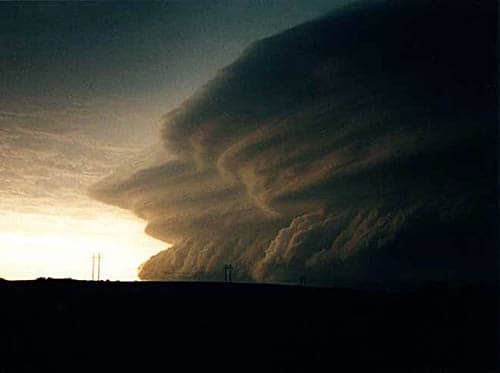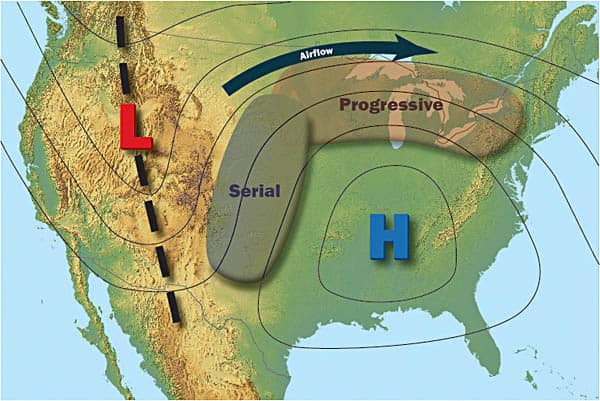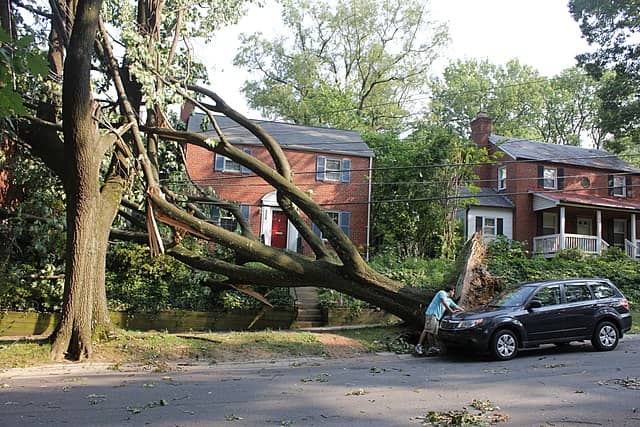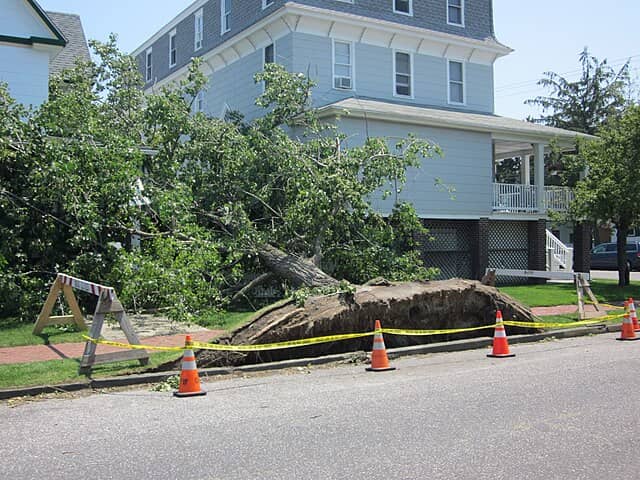When most people think of extreme storms, tornadoes and hurricanes often come to mind first. However, another severe weather phenomenon, the derecho, can be just as destructive - sometimes even more so. Derechos are long-lasting, fast-moving, and immensely powerful windstorms that travel in a straight line. Despite their ferocity, derechos remain relatively unknown to the general public. In this post, we will explore what derechos are, how they form, their impact, and how to stay safe when one strikes.
What Is a Derecho?
A derecho (pronounced “deh-RAY-cho”) is a widespread and long-lived windstorm associated with a line of severe thunderstorms. Unlike tornadoes, which produce rotating winds, derechos create straight-line winds. These winds exceed 75 mph (120 km/h) and sometimes reach hurricane-force speeds of 100 mph (160 km/h) or more. The term “derecho” comes from the Spanish word for “straight,” distinguishing these storms from the rotating winds of tornadoes.

Source: Doug Berry, National Weather Service
To be classified as a derecho, a storm system must meet specific criteria:
- The wind damage must extend for at least 250 miles (400 km).
- Wind gusts must reach at least 58 mph (93 km/h) along most of its path.
- Multiple wind gusts of at least 75 mph (120 km/h) must occur.
- The storm system must maintain a progressive motion, rather than stalling like some thunderstorms.
How Do Derechos Form?
Derechos form in environments with extreme atmospheric instability, where warm, moist air near the surface interacts with cooler, drier air aloft. The key ingredients include:
- High instability. Warm, humid air provides the necessary energy for thunderstorm development.
- Strong upper-level winds. Fast-moving jet stream winds help organize the storm into a long, linear system.
- Triggering mechanism. A cold weather front, low-pressure system, or other atmospheric disturbance initiates storm formation.
Derechos often originate from bow echoes. These are curved lines of thunderstorms that produce strong outward winds. As the storm system moves forward, powerful downdrafts push air toward the ground, creating damaging winds that fan out in a straight-line pattern. This forward momentum allows derechos to travel vast distances, sometimes covering multiple states or countries in a matter of hours.
Types of Derechos
There are two main types of derechos, classified based on their behavior and structure:
- Progressive derechos. These occur within a rapidly moving line of storms and typically affect a smaller, more concentrated area. They are common in the summer months when hot, humid conditions fuel rapid storm growth.
- Serial derechos. These derechos form within a larger, more complex storm system, often associated with a strong low-pressure system. They cover a broader area and can occur in cooler seasons, such as spring and fall.

Source: National Weather Service
Notable Derechos in History
While derechos are less well-known than tornadoes and hurricanes, they have caused some of the most extensive wind damage in recorded history. Some infamous examples include:
The 2020 Midwest Derecho
One of the most devastating derechos in recent history struck the U.S. Midwest on August 10, 2020. This storm system:
- traveled over 700 miles (1,125 km) in just 14 hours.
- produced wind gusts up to 140 mph (225 km/h), equivalent to a Category 4 hurricane.
- caused widespread power outages for millions of residents.
- resulted in over $11 billion in damage, making it one of the costliest thunderstorms ever.
The 2012 North American Derecho

Source: woodleywonderworks, CC BY 2.0, via Wikimedia Commons
In late June 2012, a massive derecho swept across the eastern United States, from the Midwest to the Atlantic Coast. This storm system:
- spanned over 700 miles (1,100 km) in just 12 hours.
- left more than four million people without power.
- claimed at least 22 lives and caused extensive property damage.
The 1998 Minnesota Derecho
On July 4, 1998, a powerful derecho struck Minnesota’s Boundary Waters Canoe Area Wilderness. With wind gusts over 100 mph (160 km/h), this storm flattened millions of trees, creating a hazardous landscape for campers and hikers. The storm resulted in severe injuries and extensive damage to the forest ecosystem.
The Dangers and Impacts of Derechos
Derechos can be just as dangerous as hurricanes or tornadoes, but they often strike with little warning. Some of the major hazards include:
- Widespread wind damage. Derechos can destroy buildings, uproot trees, and overturn vehicles.
- Power outages. The strong winds often knock down power lines, leaving large areas without electricity for days or even weeks.
- Flying debris. Winds exceeding 100 mph (160 km/h) can turn everyday objects into deadly projectiles.
- Flash flooding. Heavy rainfall accompanying derechos can lead to severe flooding, especially in urban areas.

Source: Hurricanehink, CC BY-SA 3.0, via Wikimedia Commons
How to Stay Safe During a Derecho
Because derechos can develop quickly and cover vast distances, preparation is key. Here are some tips to stay safe:
- Stay informed. Monitor weather forecasts and use the Rain Viewer weather radar to track derecho development in real time. Look for fast-moving bow echoes - curved lines of intense storms - which often indicate straight-line wind events. Activate alerts to receive real-time warnings before high winds arrive.
- Seek shelter immediately. If a derecho is approaching, move to a sturdy building. Avoid windows and stay in an interior room on the lowest floor.
- Secure outdoor items. Strong winds can carry patio furniture, trash bins, and other loose objects.
- Prepare for power outages. Keep emergency supplies on hand, including flashlights, batteries, non-perishable food, and bottled water.
- Be cautious after the storm. Downed power lines, fallen trees, and floodwaters can pose significant post-storm dangers.
Derechos vs. Tornadoes: How Do They Compare?
While derechos and tornadoes share some similarities in terms of damage potential, they are fundamentally different storms:
| Feature | Derechos | Tornadoes |
|---|---|---|
| Wind Pattern | Straight-line winds | Rotating winds |
| Size | Covers hundreds of miles | Up to a mile wide |
| Duration | Several hours | Minutes to an hour |
| Damage Path | Broad and widespread | Narrow and concentrated |
| Formation | Large-scale thunderstorms | Supercell thunderstorms |
Derechos and Tornadoes: Conclusion
Though less famous than tornadoes and hurricanes, derechos are powerful and destructive windstorms that can rival both in terms of damage and impact. Their ability to travel vast distances at high speeds makes them especially dangerous. Understanding how they form, recognizing the risks, and knowing how to stay safe can help minimize damage and save lives. By raising awareness about derechos, we can ensure more people are prepared for these extreme weather events.





